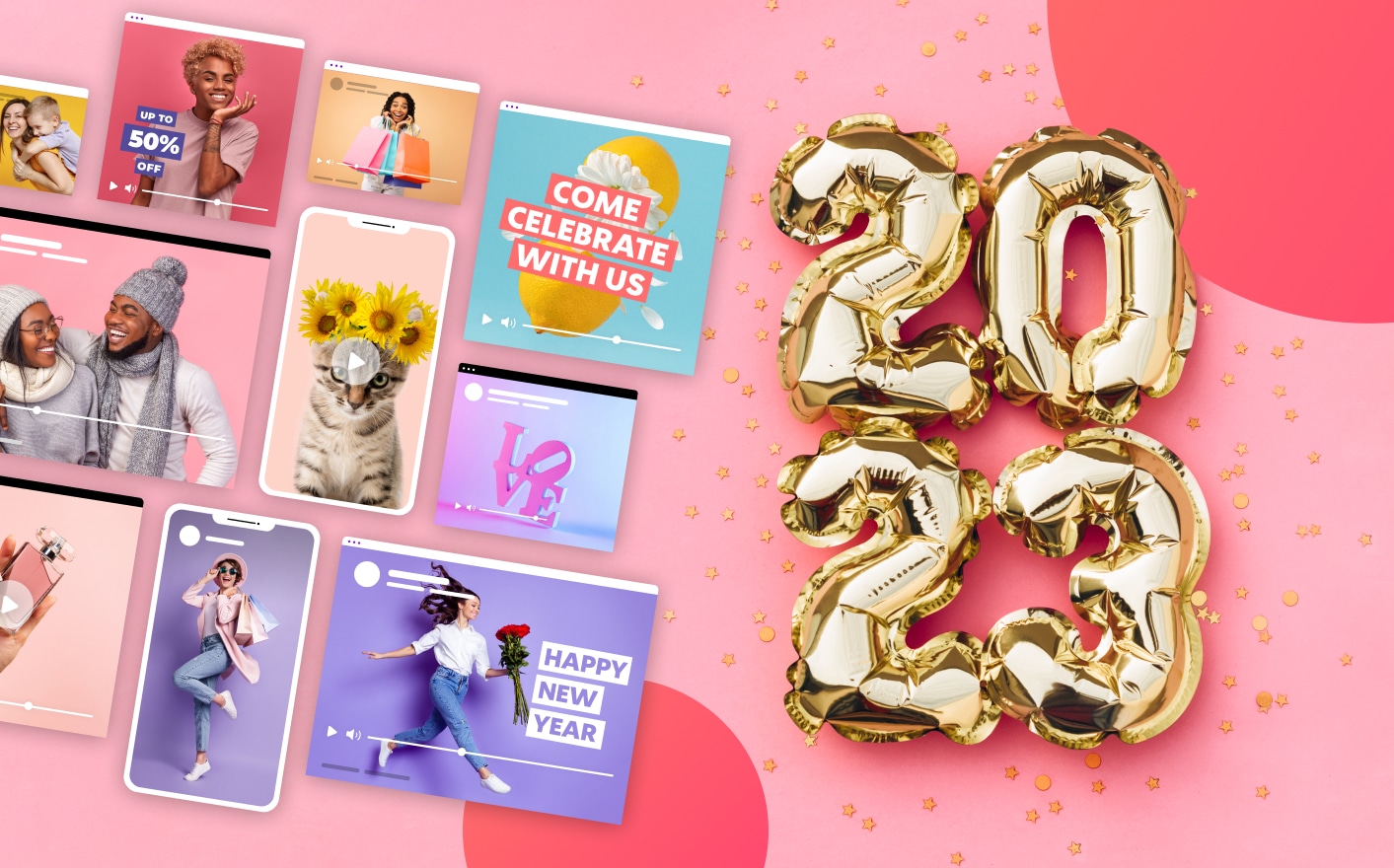
A Guide to Creating a Social Media Calendar for 2024
As a business owner in 2023, you already know that social media marketing is absolutely key to promoting your brand, finding new clients, and making sales. But most small businesses can’t exactly afford a social media manager, so how can you find a way to make it work with the limited time and resources you have?
The secret is simple yet powerful: using a social media calendar. This game-changing tool allows you to plan ahead and track all of your social media posts so that you can focus on staying organized, saving time, and seeing the bigger picture rather than spending all of your energy worrying about whether or not you’ll have time to post something this week.
If you want to start using a social media calendar in 2023, you’re in the right place. Below, we’ll give you all the information you need to get started with creating and using a social media calendar. Let’s dive in.
What Is a Social Media Calendar?
A social media calendar is a tool used to organize, plan, schedule, and track social media posts. It can be used by either a single person or a team of people who want to stay on the same page as one another.
Social media calendars can help with every task required to market on social media, including:
- Coordinating with other people
- Scheduling posts
- Pre-planning content
- Managing large-scale campaigns
- Organizing information about multiple social media accounts in one place
- Serving as a post archive
- Tracking workflow
- Tracking deadlines
- Reviewing and editing content
Social media calendars are also incredibly flexible. You can use special social media calendar software or if you’d prefer, create it entirely by hand. Heck, you can even go pencil-and-paper if you wanted to (though we wouldn’t recommend it).
It’s entirely up to you what elements you include in your social media calendar based on your needs, but it’s standard to include the following at the very least:
- The date and time when the post will be published
- The network and account the post will be published on
- Creative assets needed for the post
- Hashtags and links to include
Benefits of Using a Social Media Calendar
The advantages of a social media calendar cannot be overstated. If you’re not using one yet, it will totally transform your workflow, helping you become more organized and efficient and meet your social media marketing goals.
Some of the biggest benefits of using a social media calendar include:
- Organization – Social media marketing involves a lot of details, and it’s best to keep them all stored neatly in one place where you can easily track and find them.
- Time-saving – By keeping everything in one place and formatting it in a way that is easy to understand, a social media calendar saves a lot of time that would otherwise be wasted searching for things.
- Efficient workflow – With all of the time you save, you’ll find that the hours that you put into social media marketing become much more impactful and have higher ROI.
- Eliminating mistakes – By having everything in one accessible place, social media calendars help you avoid mistakes or confusion, especially if you have multiple people involved in social media marketing.
- Posting consistently with more ease – When you’re organized using a social media calendar, coming up with and publishing new posts becomes so much easier, lowering the effort required to keep your accounts up to date with fresh content.
- Planning strategic campaigns in advance – By helping you get all the details straight, social media calendars help you see the bigger picture so you’re able to think of your social media on a macro scale and not just a micro one. This allows you to plan larger social media campaigns rather than just posting a series of disconnected posts.
- Using occasion-based marketing – A social media calendar is an essential tool for occasion-based marketing, or the practice of promoting your brand, product, or service around a specific occasion such as a holiday.
- Using data to improve future efforts – A social media calendar becomes an invaluable source of data about your marketing efforts. You can use it to track what works and what doesn’t, generating insights that will improve your social media marketing in the future.
- Consistency – By planning ahead, you’ll be able to ensure that you post on a consistent schedule, something that is very important to finding success with social media and content marketing.
How to Create a Social Media Calendar
Whew! We told you there were a lot of benefits. But how do you actually get started with implementing a social media calendar?
1. Audit social networks and current processes
The first step to creating your social media calendar is to audit your current social networks and social media marketing workflows. If you haven’t started doing any social media marketing yet, you can skip this step.
But it’s more likely that you have, at the very least, posted here and there on Instagram or Facebook. So go ahead and do a quick audit in which you list:
- All the social media accounts you have for your business
- Who has access to each account
- The usernames of each account
- The descriptions and logos used on each account
- How many followers the account has
- Engagement levels
- How much traffic the accounts are sending to your website
With all of this information in one place, you’ll get a better sense of what needs updating and changing.
2. Create or reference existing goals
Next, you’ll want to make sure you have some social media marketing goals to serve as guidelines for the decisions you’ll make as you create your calendar. If you already have goals, great! Just revisit them and give them a refresh if necessary.
If you don’t have any goals, the best way to come up with a few is to look at your larger business goals and see how social media marketing might be able to help. For example, if your company has a goal of boosting revenue by 10% this quarter, your social media goals might be focused more on gaining new leads.
Some example social media marketing goals you can use for inspiration include:
- Reach x followers on your Instagram account by Q1
- Have a reach of at least x on each Twitter post
- Increase website traffic by x percent
- Receive at least x comments per Facebook post
3. Choose what to include in your calendar
Now it’s time to actually start building your social media calendar. To start, you’ll have to decide what you want to include in the calendar. This will depend entirely on your needs and just how granular you want to be. If your social media marketing operation is still pretty small, it might be enough for you to just include the four or five most important data points in your calendar. Or, if you prefer to get really detailed and you have multiple accounts to balance, you’ll probably need more.
A full list of the different elements you might want to add to your social media calendar includes:
- Date and time the post will be published
- Post title if relevant
- Social media network to post on
- Copy
- Hashtags and links to include
- Post type: is it new or reused?
- Post format: Is it text? Image? Infographic? Video?
- Post campaign or theme
- Link to the published post
- Status of the post: has it been written? Edited? Approved? Scheduled? Published?
If you have multiple people working on your social media, you may also want to include:
- Post owner
- Post creator
- Post reviewer
4. Choose networks and posting frequency
Now it’s time to decide on a few key details that will shape your social media calendar:
- Which social media networks will you be posting on?
- How many posts per day or week will you publish on each network?
To help you answer these questions, reference your social media audit and goals. For example, if your audit revealed that balancing five different networks is challenging for you, consider taking it down to two or three. If one of your goals is to reach as wide of an audience as possible, you might want to have a relatively high posting frequency.
For your reference, here are the recommended posting frequencies for each social media platform.
| Social Media Platform | Ideal Posting Frequency | Source |
| 2 feed posts per week and 2 stories per day | Head of Instagram Adam Mosseri | |
| Once a day to 5 times a month | Hubspot | |
| Once per day | LinkedIn’s guide for small businesses | |
| YouTube | At least one video per week | YouTube Strategist Maria Concepcion Zabala |
5. Choose planning tools and calendar format
Next, you need to decide what format your calendar will be in and what tools you’ll use to help you plan.
In terms of format, you have the option of creating a weekly, monthly, quarterly, or yearly social media calendar. It’s common – and quite helpful – to use more than just one of those. A quarterly or yearly calendar can help give you a big-picture overview of your general content themes and needs for the year, while a weekly or monthly one can offer a more micro look at every single relevant detail of each post.
As far as tools go, your options are to either create a calendar from scratch or use a template on a spreadsheet like Excel or Google Sheets, or use a social media calendar application. If you want to cut down on the number of tools you’re using Promo is a great place for a content calendar. Even better, it functions as a planner, video maker, and media library all in one to streamline your processes and store everything in one place.
6. Fill out the calendar
Now that you have an empty social media calendar, it’s time to fill it up! To do so, we recommend following these steps:
- Events and holidays – Add any events and holidays that might be relevant to your brand. In addition to major national and international holidays, there are also many social media holidays, such as National Donut Day. You can find a calendar containing these here.
- Company events and relevant dates – Next, add any dates meaningful to your brand, such as the anniversary of your founding.
- Larger-scale campaigns and themes – If you’re planning to do any social media campaigns in 2023, add those to your calendar. These include wider cultural events like Black History Month, but also occasions specific to you, like product launch promotion campaigns.
-
- UGC and reused content – If you’re planning to post any user-generated content, link to another brand’s content, or repost something from the past, this is the time to add it.
- Original ideas – Finally, it’s time to fill in original ideas for new posts. Here, it’s time to use your creativity to come up with anything you can think of. Some ideas for content include:
-
- Conversation starters and questions
- Links to blog posts
- Quotes
- Tips
- Images
- Videos
- Infographics
- Promotions of sales, services, and products
- Announcements
It’s okay if you can’t fill up the entire year’s worth of content ideas now. Planning at least a week or, ideally, a month in advance is perfect.
7. Create content
Once your social media calendar is full, it’s time for you to start actually creating the content that you’ll post on your accounts, including writing the copy, taking the photos, and editing the videos. It’s okay if you don’t have a lot of resources for this. In addition to user-generated content and links to external content, there are many resources you can use to create social media content without breaking the bank.
Promo’s online video maker is an affordable tool that helps you make high-quality social media videos in minutes. In fact, you don’t even have to start from scratch. Promo offers thousands of templates you can use. All you have to do is choose a template and customize it with your branding.
8. Schedule and publish posts
We’ve finally arrived at the last step: scheduling and publishing your social media posts. It’s best practice to use a social media scheduling tool like Promo Planner to schedule your posts in advance so they will automatically go live at the right date and time.
Using your calendar to look ahead at your upcoming posts, you can schedule them in a batch one week or even a month in advance. This will save you the effort of having to manually go in and post every day, and give you flexibility in case you aren’t always available to go on your accounts and post things yourself. (After all, you do need a vacation every once in a while.)
Promo Makes Planning Your Social Media a Breeze
In addition to our easy-to-use online video maker, Promo also offers several other features that work in conjunction with your social media calendar to help you plan ahead, get organized, and save time.
Every month, we release a monthly content calendar with ideas for social media posts you can create every day that month. We always include all of the most important holidays and events of the month, as well as some other interesting and more niche occasions. Even better, we link to a video template for each day that you can make your own to use as that day’s social media post.
Additionally, Promo Planner allows you to pre-schedule your social media posts directly from our video maker page. All you have to do is connect your social media accounts. Then, once you finish a video, you can schedule it to be posted on the date and time of your choice. This is an incredible time-saving tool that helps you make sure you never drop the ball with social media marketing.
And there you have it: everything you need to help you find success using a social media calendar. Happy planning!



